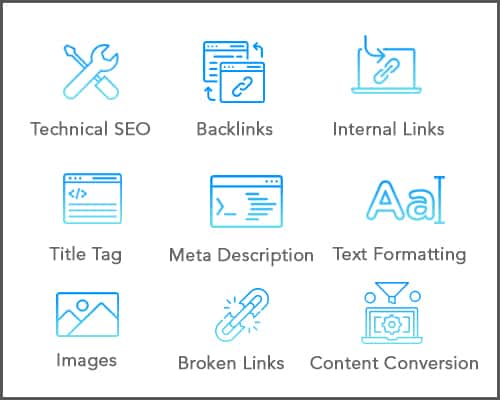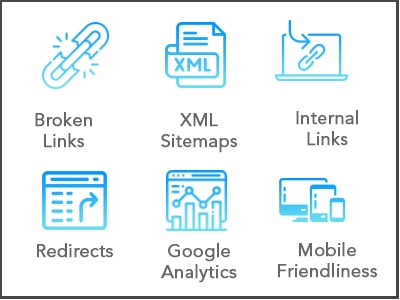For many in the SEO industry, an audit is a rite of passage. It’s one of the most important and valuable activities to get your website setup for success. If you want more traffic, it always starts with an audit.
…and audits can get complicated!

There’s some important questions you need to ask yourself early on like – What does Google think about my site? How can I make sure search engines crawl every [important] page? Or when should I do this audit again? These are all great things to consider during your first SEO audit, so don’t feel bad about asking questions!
In this blog post, we’ll walk you through what should be included in an SEO audit. Sit back, relax and learn SEO!
What’s Involved in a Typical SEO Audit?
An SEO audit is the process of examining every aspect of your website to make sure Google can find it. This includes everything from making sure you have descriptive titles and meta descriptions on all pages, ensuring there are no broken links or duplicate content issues, manually submitting your site to Google Search Console (formerly Webmaster Tools), and verifying all images include meaningful ALT tags, etc.
That’s a lot, huh? Don’t worry, we’ll break it all down and keep things simple…
The Importance of an SEO Audit
Why’s this so important? There are plenty of good reasons to audit your website. First and foremost, your website is PUBLIC FACING…If you think of your website as a storefront, it’s not going to attract many customers if it’s dark and dreary, is it?

When customers can’t see what’s for sale and easily get in touch with you, they lose trust. You need Google to find your site and rank it in their search results to earn the respect of potential customers.
By conducting an SEO audit you’ll be able to see deficiencies your website has and fix them before it affects your ranking negatively. Without doing a regular SEO audit, you’re in the dark on what may be causing your site’s poor ranking or why you’re seeing less traffic in Analytics.
What is included in an SEO Audit?
Although there is no hard and fast rules when it comes to SEO audits, you need to keep in mind that the audit report should showcase a full picture of the website and all possible issues hindering optimum performance.
An entire day would not be enough for us to discuss what should be included in a comprehensive SEO audit but in general, you may want to check the following areas:

- Technical SEO and Core Web Vitals performance.
- Existing backlinks and external pages that are pointing to your site for link-building purposes.
- Internal linking – Having internal pages that are linked together is important.
- Title tags and meta descriptions – When it comes to titles and descriptions, you need to make sure that they’re unique for each page and that there are no duplicate titles and meta descriptions on any of your site’s pages.
- Text formatting – It’s important that you don’t just have plain text on your pages. Make use of H1, H2, bold, italics, etc. Doing this will make your page more readable for users and search-engine friendly.
- Images – Images are an important part of every website. It makes a page more lively and interesting. You need to be careful not to overdo it though, as it can affect your page’s load speed.
- Broken links or Broken Links.
- URL Structure
- Current content conversion data and opportunities.
- Website elements that are disrupting the user experience.
A Simple Four-Step SEO Audit
Step 1. Conduct a full website/crawl audit.
The very first step in an SEO audit is to look into every detail of your website, looking into every page just how a search engine would do it. This is a crucial part that should be done very carefully as it’s where you will find any deficiencies you need to take action and fix.

Step 2. Prepare and Process the SEO Audit Report.
After conducting a thorough website crawl, you’ll have to prepare a detailed report that contains all the findings from the first step. The audit report will contain comprehensive detail regarding the following areas:

- Broken Links
- Internal Links
- On-Page SEO
- Indexability
- Redirects
- XML Sitemaps
- Organic Rankings
- Google Search Console
- Google Analytics
- Page Speed / Core Web Vitals
- Duplicate Content
- Front End Functionality
- Mobile Friendliness
- Security Concerns
- Organic Search Traffic
If there are areas underperforming, take a deeper look to figure out causes and find a solution.
Step 3. Documentation
With a detailed report in place, the next step is to document everything that’s been uncovered and what’s been done. Depending on the severity of the case, the final documentation can be as long as 100+ pages. Review it as carefully as possible.

Step 4. Review the Audit
As mentioned above, you need to set aside enough undisturbed time to review the comprehensive documentation, especially in areas that are underperforming. This is where you’ll be able to identify the exact issues that affect the website’s ranking.

Conclusion
An SEO audit is not something you should do every day. It’s a process you’ll need to conduct at least once every six months or yearly, depending on the current status of your website.
It may require a lot of time and hard work, but we assure you that it all pays off in the long run.
Having an SEO-optimized website is crucial to beating your competition and getting more traffic. Don’t take any shortcuts and conduct a comprehensive SEO audit, regularly.
If you need help, Webology offers free website audits to give you a detailed roadmap to success.



